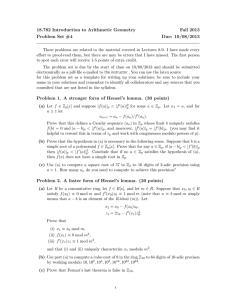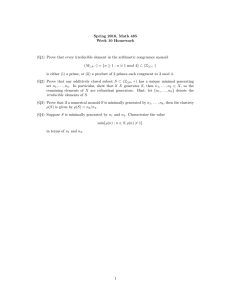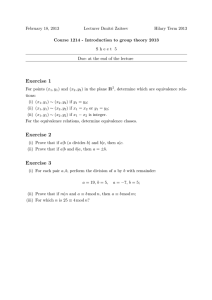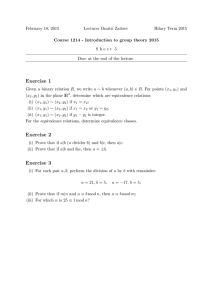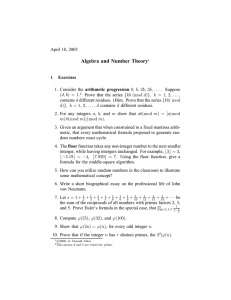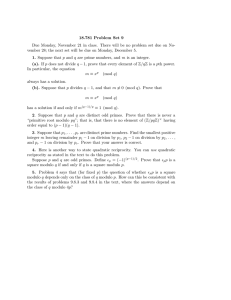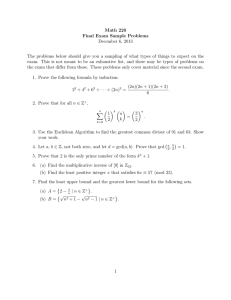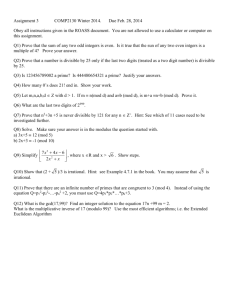18.782 Introduction to Arithmetic Geometry Fall 2013 Problem Set #4 Due: 10/08/2013
advertisement
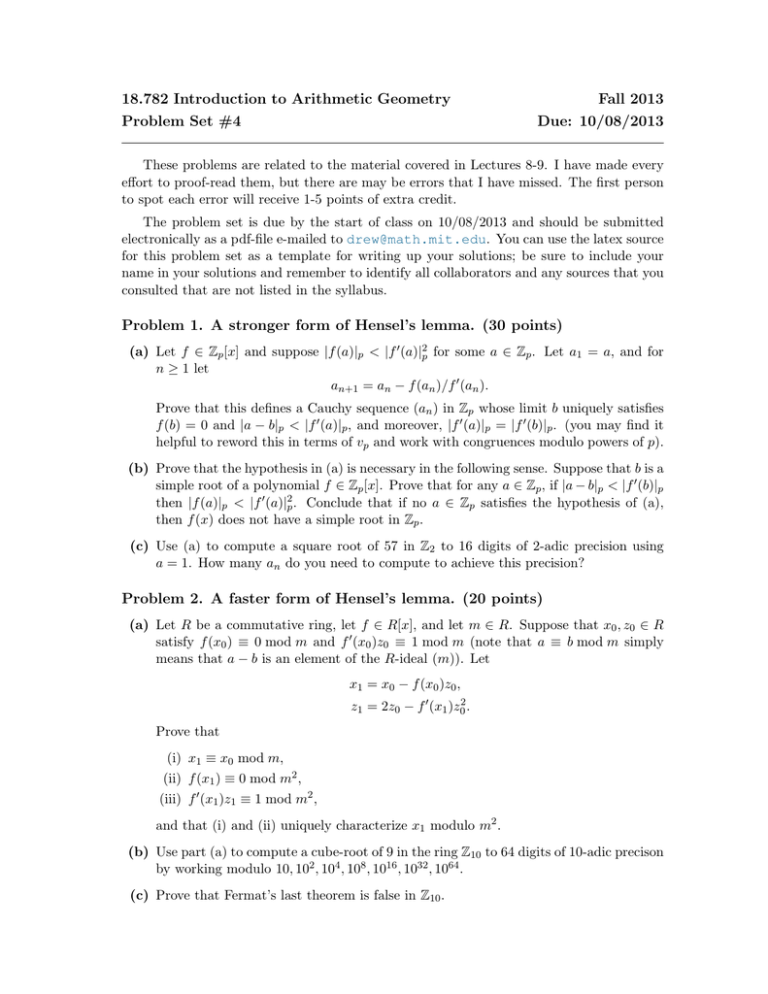
18.782 Introduction to Arithmetic Geometry
Problem Set #4
Fall 2013
Due: 10/08/2013
These problems are related to the material covered in Lectures 8-9. I have made every
effort to proof-read them, but there are may be errors that I have missed. The first person
to spot each error will receive 1-5 points of extra credit.
The problem set is due by the start of class on 10/08/2013 and should be submitted
electronically as a pdf-file e-mailed to drew@math.mit.edu. You can use the latex source
for this problem set as a template for writing up your solutions; be sure to include your
name in your solutions and remember to identify all collaborators and any sources that you
consulted that are not listed in the syllabus.
Problem 1. A stronger form of Hensel’s lemma. (30 points)
(a) Let f ∈ Zp [x] and suppose |f (a)|p < |f 0 (a)|2p for some a ∈ Zp . Let a1 = a, and for
n ≥ 1 let
an+1 = an − f (an )/f 0 (an ).
Prove that this defines a Cauchy sequence (an ) in Zp whose limit b uniquely satisfies
f (b) = 0 and |a − b|p < |f 0 (a)|p , and moreover, |f 0 (a)|p = |f 0 (b)|p . (you may find it
helpful to reword this in terms of vp and work with congruences modulo powers of p).
(b) Prove that the hypothesis in (a) is necessary in the following sense. Suppose that b is a
simple root of a polynomial f ∈ Zp [x]. Prove that for any a ∈ Zp , if |a − b|p < |f 0 (b)|p
then |f (a)|p < |f 0 (a)|2p . Conclude that if no a ∈ Zp satisfies the hypothesis of (a),
then f (x) does not have a simple root in Zp .
(c) Use (a) to compute a square root of 57 in Z2 to 16 digits of 2-adic precision using
a = 1. How many an do you need to compute to achieve this precision?
Problem 2. A faster form of Hensel’s lemma. (20 points)
(a) Let R be a commutative ring, let f ∈ R[x], and let m ∈ R. Suppose that x0 , z0 ∈ R
satisfy f (x0 ) ≡ 0 mod m and f 0 (x0 )z0 ≡ 1 mod m (note that a ≡ b mod m simply
means that a − b is an element of the R-ideal (m)). Let
x1 = x0 − f (x0 )z0 ,
z1 = 2z0 − f 0 (x1 )z02 .
Prove that
(i) x1 ≡ x0 mod m,
(ii) f (x1 ) ≡ 0 mod m2 ,
(iii) f 0 (x1 )z1 ≡ 1 mod m2 ,
and that (i) and (ii) uniquely characterize x1 modulo m2 .
(b) Use part (a) to compute a cube-root of 9 in the ring Z10 to 64 digits of 10-adic precison
by working modulo 10, 102 , 104 , 108 , 1016 , 1032 , 1064 .
(c) Prove that Fermat’s last theorem is false in Z10 .
Problem 3. Applications of Hensel’s lemma (50 points)
r
×
Recall that every element of Q×
p can be uniquely written as p u with r ∈ Z and u ∈ Zp .
Let Qp×n = {xn : x ∈ Qp } denote the set of nth powers in Q×
p.
(a) For all odd primes p, prove that pr u is a square in Q×
p if and only if r is even and u
×
×2
is a square modulo p. Conclude that Qp /Qp ' (Z/2Z)2 (as finite abelian groups).1
(b) Using the strong form of Hensel’s lemma, prove that 2r u is a square in Q×
2 if and only
×
×2
3
if r is even and u ≡ 1 mod 8. Conclude that Q2 /Q2 ' (Z/2Z) .
×n
(c) Determine the structure of Q×
p /Qp for all primes p and odd primes n.
Let µn,p = {x ∈ Qp : xn = 1} denote the set of nth roots of unity in Qp .
(d) Prove that µn,p is a subgroup of Z×
p.
(e) Use Hensel’s lemma to prove that for p - n the group µn,p is cyclic of order gcd(n, p−1).
(f ) Let p be odd. Use the strong form of Hensel’s lemma to prove that µp,p is trivial.
Conclude that there are exactly p − 1 roots of unity in Qp (be sure to address µpr ,p ).
(g) Prove that µ4,2 = µ2,2 = {±1}. Conclude that ±1 are the only roots of unity in Q2 .
Problem 4. Survey
Complete the following survey by rating each problem on a scale of 1 to 10 according to how
interesting you found the problem (1 = “mind-numbing,” 10 = “mind-blowing”), and how
difficult you found the problem (1 = “trivial,” 10 = “brutal”). Also estimate the amount
of time you spent on each problem.
Interest
Difficulty
Time Spent
Problem 1
Problem 2
Problem 3
Please rate each of the following lectures that you attended, according to the quality of the
material (1=“useless”, 10=“fascinating”), the quality of the presentation (1=“epic fail”,
10=“perfection”), the pace (1=“way too slow”, 10=“way too fast”), and the novelty of the
material (1=“old hat”, 10=“all new”).
Date
10/1
10/3
Lecture Topic
Hensel’s lemma
Quadratic forms
Material
Presentation
Pace
Novelty
Feel free to record any additional comments you have on the problem sets or lectures; in
particular, how you think they might be improved.
1
Anytime Z/pZ (or any ring for that matter) appears in a context where a group is required, you can
assume it is the additive group that is being referred to (one uses (Z/pZ)× for the multiplicative group).
